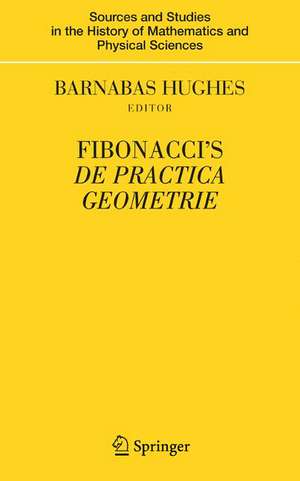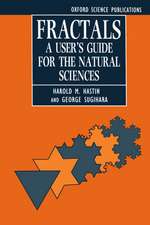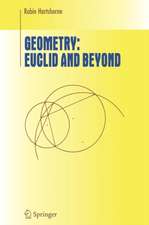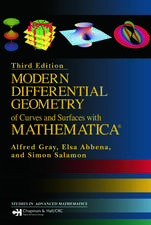Fibonacci's De Practica Geometrie: Sources and Studies in the History of Mathematics and Physical Sciences
Autor Barnabas Hughesen Limba Engleză Hardback – 29 noi 2007
This translation offers a reconstruction of De practica geometrie as the author judges Fibonacci wrote it. In order to appreciate what Fibonacci created, the author considers his command of Arabic, his schooling, and the resources available to him. To these are added the authors own views on translation and remarks about prior Italian translations. A bibliography of primary and secondary resources follows the translation, completed by an index of names and special words.
| Toate formatele și edițiile | Preț | Express |
|---|---|---|
| Paperback (1) | 897.14 lei 6-8 săpt. | |
| Springer – 29 noi 2010 | 897.14 lei 6-8 săpt. | |
| Hardback (1) | 901.26 lei 6-8 săpt. | |
| Springer – 29 noi 2007 | 901.26 lei 6-8 săpt. |
Din seria Sources and Studies in the History of Mathematics and Physical Sciences
- 20%
 Preț: 756.13 lei
Preț: 756.13 lei - 18%
 Preț: 907.11 lei
Preț: 907.11 lei - 15%
 Preț: 667.86 lei
Preț: 667.86 lei - 18%
 Preț: 1434.29 lei
Preț: 1434.29 lei -
 Preț: 387.75 lei
Preț: 387.75 lei - 15%
 Preț: 638.57 lei
Preț: 638.57 lei - 18%
 Preț: 896.70 lei
Preț: 896.70 lei - 15%
 Preț: 643.65 lei
Preț: 643.65 lei - 18%
 Preț: 916.25 lei
Preț: 916.25 lei - 18%
 Preț: 1124.92 lei
Preț: 1124.92 lei - 18%
 Preț: 963.29 lei
Preț: 963.29 lei - 15%
 Preț: 652.31 lei
Preț: 652.31 lei - 18%
 Preț: 1244.89 lei
Preț: 1244.89 lei - 23%
 Preț: 686.57 lei
Preț: 686.57 lei - 15%
 Preț: 649.71 lei
Preț: 649.71 lei -
 Preț: 390.25 lei
Preț: 390.25 lei - 15%
 Preț: 644.18 lei
Preț: 644.18 lei - 15%
 Preț: 580.17 lei
Preț: 580.17 lei - 18%
 Preț: 1123.35 lei
Preț: 1123.35 lei - 15%
 Preț: 641.03 lei
Preț: 641.03 lei - 15%
 Preț: 581.14 lei
Preț: 581.14 lei - 18%
 Preț: 796.31 lei
Preț: 796.31 lei - 18%
 Preț: 2119.49 lei
Preț: 2119.49 lei - 24%
 Preț: 860.16 lei
Preț: 860.16 lei - 15%
 Preț: 645.14 lei
Preț: 645.14 lei -
 Preț: 384.48 lei
Preț: 384.48 lei - 18%
 Preț: 1410.63 lei
Preț: 1410.63 lei - 18%
 Preț: 969.28 lei
Preț: 969.28 lei - 15%
 Preț: 642.03 lei
Preț: 642.03 lei - 18%
 Preț: 1113.71 lei
Preț: 1113.71 lei - 15%
 Preț: 662.16 lei
Preț: 662.16 lei - 18%
 Preț: 963.29 lei
Preț: 963.29 lei - 15%
 Preț: 647.59 lei
Preț: 647.59 lei -
 Preț: 395.63 lei
Preț: 395.63 lei - 18%
 Preț: 941.50 lei
Preț: 941.50 lei - 15%
 Preț: 709.56 lei
Preț: 709.56 lei - 15%
 Preț: 695.53 lei
Preț: 695.53 lei - 24%
 Preț: 1294.90 lei
Preț: 1294.90 lei
Preț: 901.26 lei
Preț vechi: 1099.10 lei
-18% Nou
Puncte Express: 1352
Preț estimativ în valută:
172.45€ • 180.54$ • 142.70£
172.45€ • 180.54$ • 142.70£
Carte tipărită la comandă
Livrare economică 05-19 aprilie
Preluare comenzi: 021 569.72.76
Specificații
ISBN-13: 9780387729305
ISBN-10: 0387729305
Pagini: 408
Ilustrații: XXXVI, 412 p. 416 illus.
Dimensiuni: 155 x 235 x 25 mm
Greutate: 0.74 kg
Ediția:2008
Editura: Springer
Colecția Springer
Seria Sources and Studies in the History of Mathematics and Physical Sciences
Locul publicării:New York, NY, United States
ISBN-10: 0387729305
Pagini: 408
Ilustrații: XXXVI, 412 p. 416 illus.
Dimensiuni: 155 x 235 x 25 mm
Greutate: 0.74 kg
Ediția:2008
Editura: Springer
Colecția Springer
Seria Sources and Studies in the History of Mathematics and Physical Sciences
Locul publicării:New York, NY, United States
Public țintă
Professional/practitionerCuprins
Measuring Areas of Rectangular Fields.- Finding Roots of Numbers.- Measuring All Kinds of Fields.- Dividing Fields Among Partners.- Finding Cube Roots.- Finding Dimensions of Bodies.- Measuring Heights, Depths, and Longitude of Planets.- Geometric Subtleties.
Recenzii
From the reviews:
"This is a translation of a book written in 1223. It was designed for those who had to solve practical problems such as finding areas and roots, measuring fields of all kinds, dividing fields among partners, measuring dimensions of bodies and heights, depths, longitude of planets, etc. It’s a joy to read. The translation is charming. … De practica geometrie belongs in every library that supports graduate mathematics programs and also those that support programs in education." (Donald Cook, Mathematical Reviews, Issue 2008 k)
"In this book Fibonacci not only collected the plane geometry of Euclid but went far beyond. He included the use of trigonometry and algebra to solve geometrical problems … . Each chapter is accompanied by comments which serve as guidelines through the book. The book can be read with much pleasure. … Hughes has certainly presented a major scholarly work and … his translation will be read by many interested mathematicians and historians of science." (Thomas Sonar, Zentralblatt MATH, Vol. 1145, 2008)
"This is a translation of a book written in 1223. It was designed for those who had to solve practical problems such as finding areas and roots, measuring fields of all kinds, dividing fields among partners, measuring dimensions of bodies and heights, depths, longitude of planets, etc. It’s a joy to read. The translation is charming. … De practica geometrie belongs in every library that supports graduate mathematics programs and also those that support programs in education." (Donald Cook, Mathematical Reviews, Issue 2008 k)
"In this book Fibonacci not only collected the plane geometry of Euclid but went far beyond. He included the use of trigonometry and algebra to solve geometrical problems … . Each chapter is accompanied by comments which serve as guidelines through the book. The book can be read with much pleasure. … Hughes has certainly presented a major scholarly work and … his translation will be read by many interested mathematicians and historians of science." (Thomas Sonar, Zentralblatt MATH, Vol. 1145, 2008)
Textul de pe ultima copertă
Leonardo da Pisa, perhaps better known as Fibonacci (ca. 1170 - ca. 1240), selected the most useful parts of Greco-Arabic geometry for the book known as De practica geometrie. Beginning with the definitions and constructions found early on in Euclid's Elements, Fibonacci instructed his reader how to compute with Pisan units of measure, find square and cube roots, determine dimensions of both rectilinear and curved surfaces and solids, work with tables for indirect measurement, and perhaps finally fire the imagination of builders with analyses of pentagons and decagons. His work exceeded what readers would expect for the topic.
Practical Geometry is the name of the craft for medieval landmeasurers, otherwise known as surveyors in modern times. Fibonacci wrote De practica geometrie for these artisans, a fitting complement to Liber abbaci. He had been at work on the geometry project for some time when a friend encouraged him to complete the task, which he did, going beyond the merely practical, as he remarked, "Some parts are presented according to geometric demonstrations, other parts in dimensions after a lay fashion, with which they wish to engage according to the more common practice."
This translation offers a reconstruction of De practica geometrie as the author judges Fibonacci wrote it. In order to appreciate what Fibonacci created, the author considers his command of Arabic, his schooling, and the resources available to him. To these are added the authors own views on translation and remarks about early Renaissance Italian translations. A bibliography of primary and secondary resources follows the translation, completed by an index of names and special words.
Practical Geometry is the name of the craft for medieval landmeasurers, otherwise known as surveyors in modern times. Fibonacci wrote De practica geometrie for these artisans, a fitting complement to Liber abbaci. He had been at work on the geometry project for some time when a friend encouraged him to complete the task, which he did, going beyond the merely practical, as he remarked, "Some parts are presented according to geometric demonstrations, other parts in dimensions after a lay fashion, with which they wish to engage according to the more common practice."
This translation offers a reconstruction of De practica geometrie as the author judges Fibonacci wrote it. In order to appreciate what Fibonacci created, the author considers his command of Arabic, his schooling, and the resources available to him. To these are added the authors own views on translation and remarks about early Renaissance Italian translations. A bibliography of primary and secondary resources follows the translation, completed by an index of names and special words.
Caracteristici
High quality translation with supplemental text to explain text that has been more freely translated Contains informative commentary preceding each chapter of text Presents the resources upon which Fibonacci based his work, thereby correcting inaccuracies found in numerous modern histories Offers numerous examples of medieval computations and logical proof regarding mathematics that was important throughout the 11th-12th centuries Includes supplementary material: sn.pub/extras


















